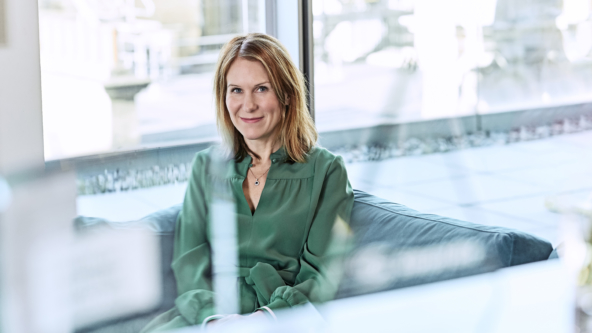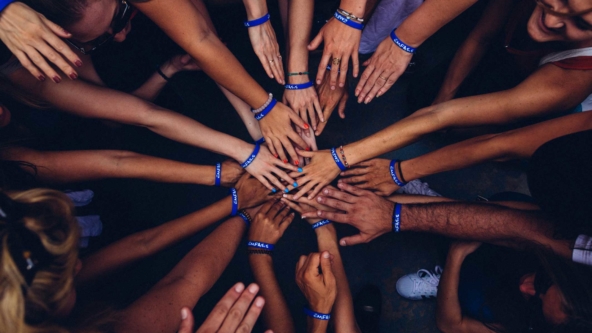At Octopus we go to great lengths to create an entrepreneurial working environment. But what does ‘the workplace of the future’ look like from an Octopus perspective?
The changing world of work
Work isn’t what it used to be. It’s not just the type of jobs that have changed, who, how and where we work has too. In the quite not-so-distant past, the concept of ‘work’ was static. It was a place you went and stayed until you were handed the obligatory carriage clock for half a lifetime of toil. Equipment was limited to the typewriter and landline. Communicating meant face to face or voice contact and a handwritten memo was the equivalent of ‘on-the-go’ messaging.
Work environments were also heavily biased according to gender. In 1971, 92% of men were employed compared to just 53% of women. More than half of employees in 1977 thought men should earn more while women stayed at home. In terms of stress management, you could still light up at your desk until smoking in enclosed spaces was banned in 2007.
Today’s workplace landscape
Fast-forward a few decades and the current landscape of work couldn’t be any more different. Work is no longer a place to go, it’s something we do. With the advent of laptops, tablets and virtual networks, work is wherever we want it to be.
We change jobs almost twice as often as our parents and grandparents and are more likely to change career completely. We can communicate in an overwhelming number of ways and the employment gap between men and women is less than 10%.
Attitudes are also changing, employees today are more interested in how work can contribute to their own sense of wellbeing. Reinforcing this, is a study carried out by professional services network PwC who found that 83% of employees feel their wellbeing influences their productivity.
Insurance provider Unum also found that 21st-century workers want to work for organisations that encourage mindfulness in a collaborative, cross-generational, intuitive workplace.
But while workers are clear about what they want and need to be productive, the reality is that those needs aren’t necessarily being met.
The productivity puzzle
A survey for TotallyMoney.com found that despite putting in more hours than some of our European counterparts, UK workers simply weren’t as productive. Tellingly, the most productive countries worked far fewer hours, had more leisure time and were generally happier.
Evidence suggests that despite the landscape of work changing, it’s an illusion that work has changed for the better. Advanced technology, more means of communication, gender levelling and flitting from job to job hasn’t necessarily made us any more efficient, happier, or better at what we do.
So, while the concept of work has been liberated, it now means that where work used to happen ‘elsewhere’ work is now ‘everywhere’ and that comes at a human price.
Virtual access to work creates a very real problem, with Unum’s report highlighting that 73% of employees said they felt pressured to be available around the clock. Feeling the need to be permanently on call increases stress which is bad for business.
The CIPD found that stress combined with other mental health issues, is now one of the top reasons for long-term absence from work. Absenteeism due to mental health issues has also increased since 2016. Evidently, genuine solutions that keep pace with the evolving world of work have yet to be found.
An innovative company needs workplace innovation
We want Octopus to be a place where people have the tools to excel and feel empowered to achieve and succeed. It’s a goal that we believe is worth striving for. In its annual health, wellbeing and absence survey, the Chartered Institute of Personnel and Development (CIPD) found that investing in staff health and wellbeing boosted employee morale, created a more inclusive culture and lowered sickness levels.
These are all positives that make work a better place to be but how do we get there and what does ‘the workplace of the future’ look like from an Octopus perspective?
Future workspace
Questions about how we can create a workplace that works now and in the future are tricky to answer. And if employees want an environment that nurtures their wellbeing – what does this look like too?
Research commissioned by interior design and architecture practice MoreySmith predicts that organisations will need to be ‘human-centric’ encouraging human collaboration – an antidote to technological overload in recent years.
In its report for MoreySmith, The Future Laboratory sees office space becoming more hospitable, warmer and softer. Filled with natural materials, plants, daylight and ambient lighting, it will be tactile and organic – less space-age and more home-spun. Zoned areas including quiet spaces will give onsite workers the opportunity to offset life in the digital fast lane. Team silos won’t exist as floorspace is designed to encourage cross-channel communication, interaction and creativity.
The concept of wellness and wellbeing that are so important to productivity will be seamlessly woven into the physical environment as well as into everyday practices, such as more flexible hours and remote working. Technological advancements will connect workers across the country and beyond so that dialling in your avatar using virtual reality could eventually be as commonplace as communicating over Skype.
Organisations will support the emotional needs of staff through comprehensive wellbeing programmes. Physical welfare will be monitored using artificial intelligence (AI) and sentient workstations will check heart rates, stress levels and screen time.
Underpinning all the tangible changes, will be that fundamental shift in attitudes towards work that we’re already starting to see. Work will become less about money and become something we choose to do and find fulfilling. Trust will play an ever increasing and important role in how we work and communicate.
The future, now
Sentient workspace and AI might be a bold step into a future unknown, but the idea of using technology to enhance work rather than engulf workers, is already something we practise here at Octopus. We embrace technology, but it’s not about colleagues being on call 24/7.
Technology connects our people in ways that let us embody the ‘one team’ approach. Colleagues might work remotely, but they’re connected using innovative communication tools like Slack and Trello. Far from being yet another way to be contacted, these apps streamline conversations allowing users to channel ideas so that teams can collaborate simultaneously, wherever they are.
But while technology gives us the opportunity to change the ways in which we work, defining how we want to work in the future is trickier to pinpoint. For Jen Viccars, Head of Brand and Marketing at Octopus Group, the workplace of the future “doesn’t have a one size fits all, off-the-shelf solution”.
Effective communication and trust
Finding out what Octopus employees want at work means asking questions, and paying attention to what the people who work here are telling us. Tools like Officevibe give us insight into what our employees are thinking and feeling so that we can find solutions before they become problems. We use ENPS (employee net promoter scores) to see how we’re faring as an organisation people want to work for. We also calculate wellness scores based on personal health and stress levels.
Tools like these aren’t just trendy tick box exercises, they’re vital in helping us all understand how we can work better as a team. More importantly, it’s a demonstration of trust and our employees have faith that we’ll act on what we find.
As Jen Viccars says: “The workplace of the future won’t just see the value of getting a snapshot view of the mood and engagement of employees, but it actually uses the data generated to take action. The workplaces people want to leave are those that come across like they’re interested, but then fail to take action on the stark realities that employee mood data can sometimes give.”
Trust has also enabled Octopus to introduce innovative new ways of working. Flexible working means that we can harness talent regardless of where and how individuals want to work. Generous maternity and shared parental leave schemes mean that new parents don’t have to sacrifice family for finances.
We’ve also initiated ‘take what you need’ holidays which offer exactly that. The idea is simple – we don’t count the number of days off staff have but trust that they’ll do the right thing and make decisions that help them strike a genuine balance between work and leisure.
Yoga and beyond
Central to making sure our workforce is happy, healthy and productive – is health and wellbeing. But even getting to grips with this, can be difficult. What is ‘being healthy’ and what does feeling good and working well actually mean in a diverse and growing workplace?
Philippa Russ, Head of Central Change at Octopus, understands that wellbeing is a diverse subject and means different things to different people. She explains that the Octopus vision of wellness and wellbeing is “not prescriptive and applies to both the physical and mental”.
Catering to variety, a cross-functional team organises wellness classes and events so Octopus employees can socialise with colleagues encouraging even greater interaction. The clubs are as varied as our people – yoga, backgammon, gardening and skiing – there’s something for everyone.
It’s a broad programme that lets us live the concept of work being somewhere you want to be and choose to go. Kevin Dowling, Head of Content at Octopus says: “There’s no excuse to feel chained to your desk or feel like just a ‘cog in the machine’, everyone here is encouraged to find what makes them happy and do it”.
Mental wellbeing is a hugely important aspect of overall wellness and something we feel strongly about. It’s why we’ve started working with Sanctus, a company on a mission to change perceptions of what ‘mental health’ is. Together, we want to ensure Octopus people are given the support to be open about how they really are, so they can bring their complete selves to work.
Key to wellbeing is appreciating that a human workforce evolves and yearns for personal and professional development. We trust our people to tell us what work-based training they need and they trust us to provide it. But it doesn’t stop there. Using the Udemy platform of online courses our employees can explore their own interests. We want staff to feel fulfilled in their personal lives and be happy in a work environment that values them as a whole.
A workspace that works
One aspect of the future workplace that we’re delving further into is how we use our physical space. We already use adjustable GeekDesks to help reduce musculoskeletal aches and pains – another main cause of short and long-term absence according to the CIPD.
We’ve also set up communal workspaces and abundant meeting rooms encourage interaction and creativity. Coffee station hubs encourage “unexpected collaboration”, as Philippa neatly puts it, but we know we need to go further and create a physical environment that matches our dynamism and innovation.
Having rapidly grown over the last two years, we’re now at a point where we need to be smart with our space or we’ll quite literally run out of desks. Creating neighbourhoods of workers rather than silos, quiet pods, libraries and areas for project work and collaboration are all elements that could make up our future workspace.
It’s clear that there is no one vision of the workplace of the future. The right model will be the one that meets the needs of the people who work for that organisation. As Philippa says: “There is no one right way and it’s about people finding their own way. Perceptions change about ways of working, it’s about being adaptable”.
For us, the workplace of the future is an ecosystem. Where our values, diverse workforce and physical space interact in a way that is uniquely Octopus – flexible, enterprising and evolutionary.


